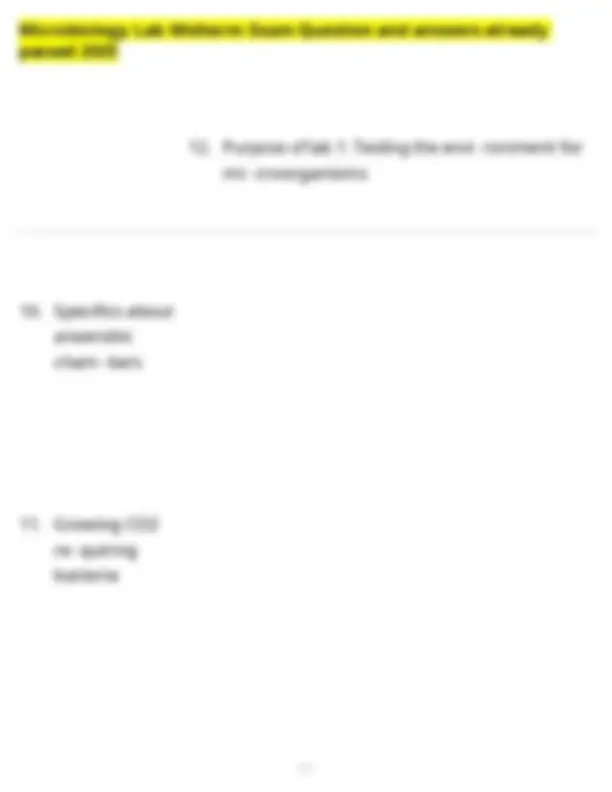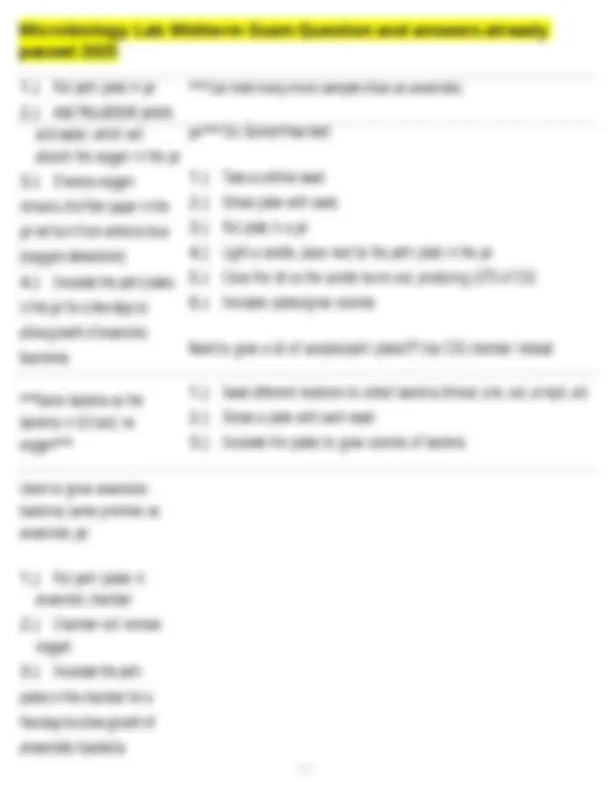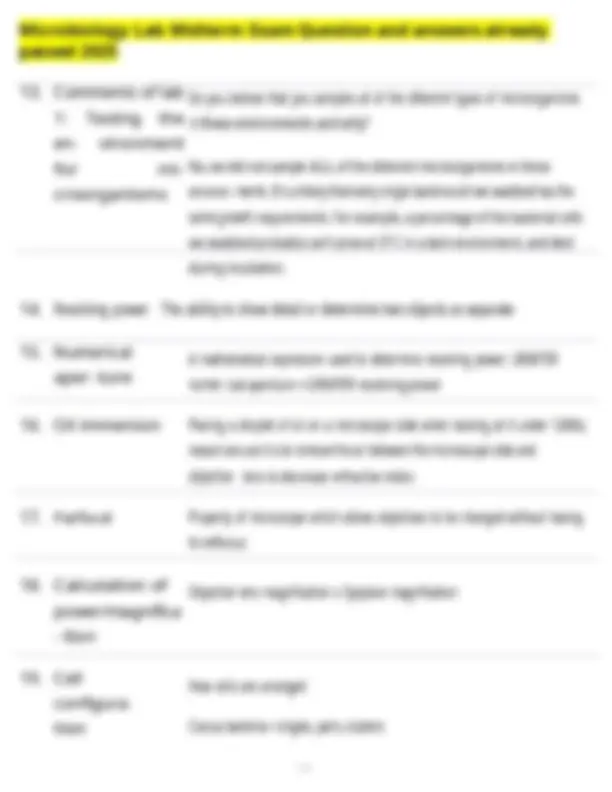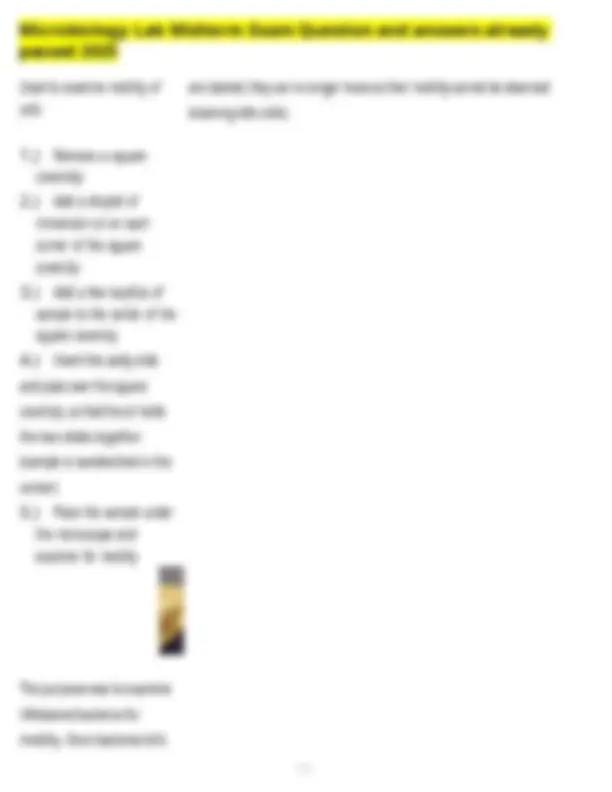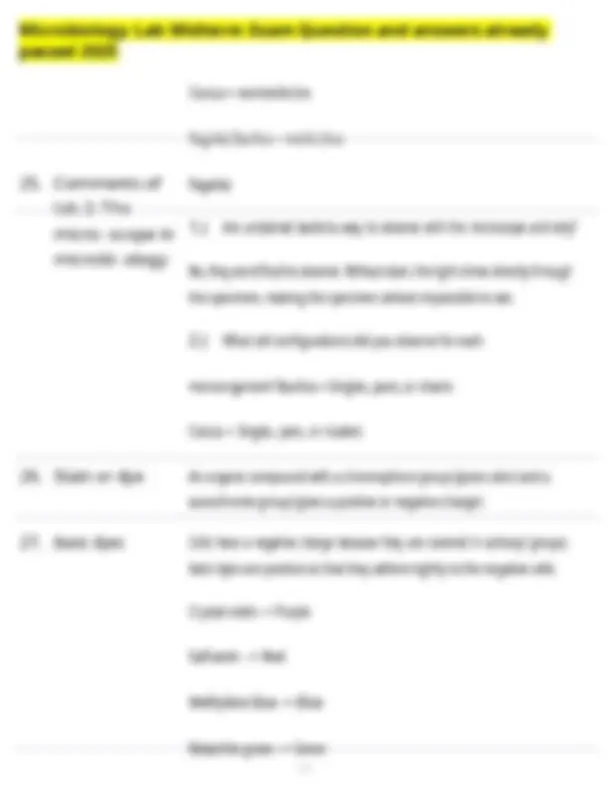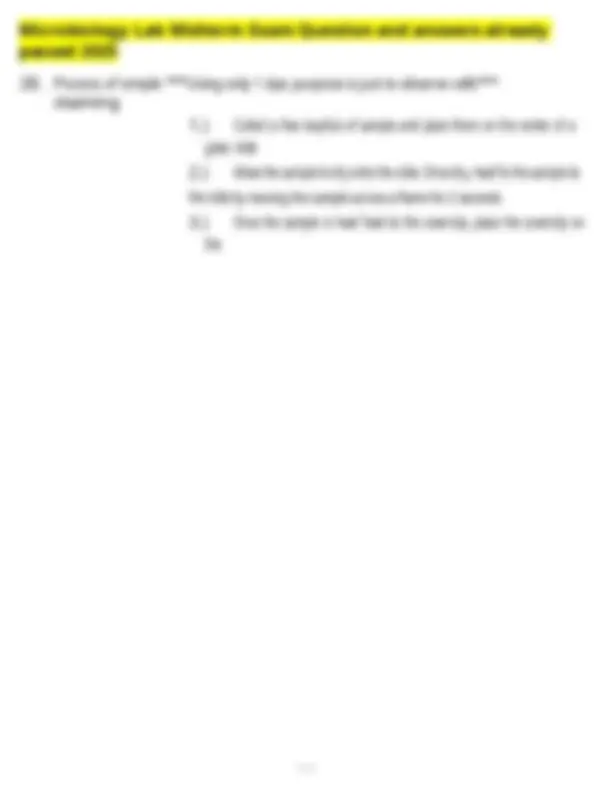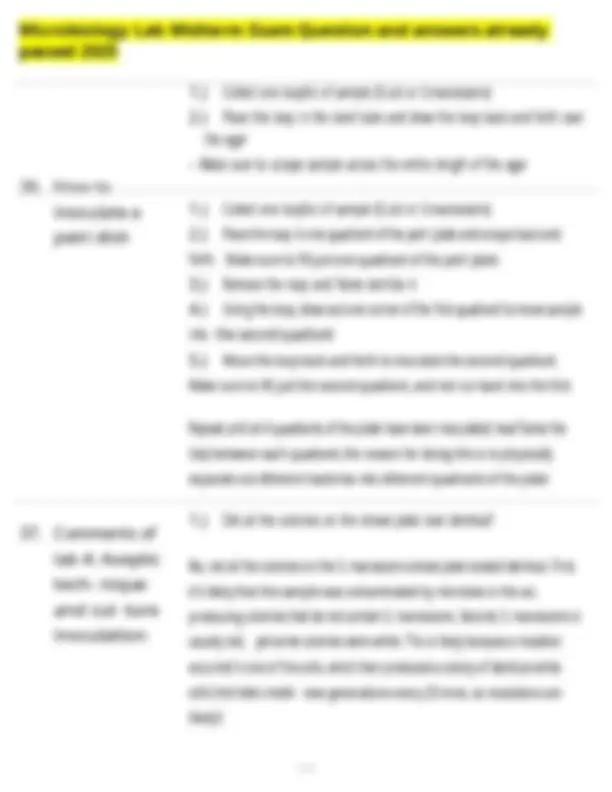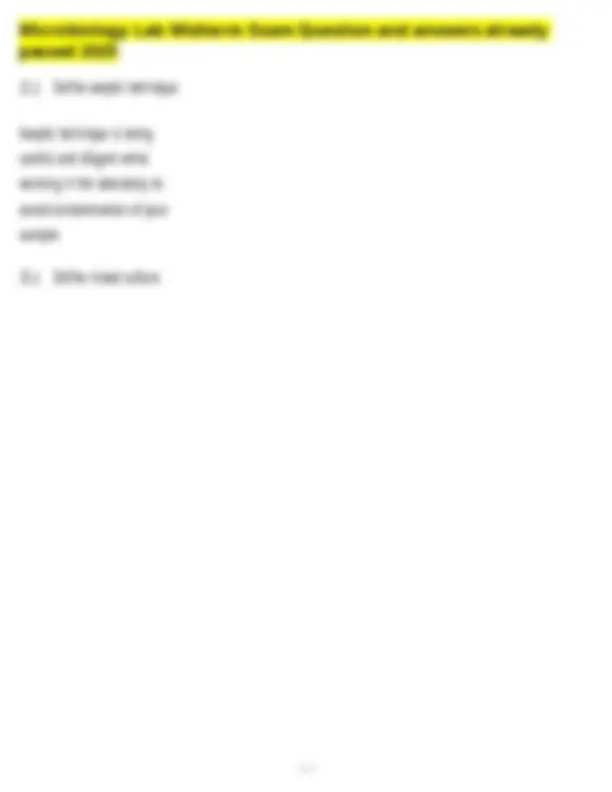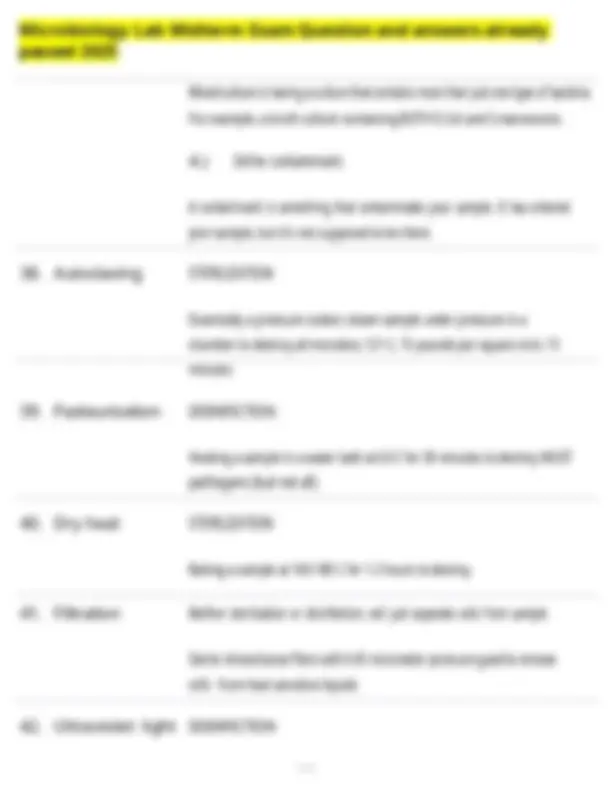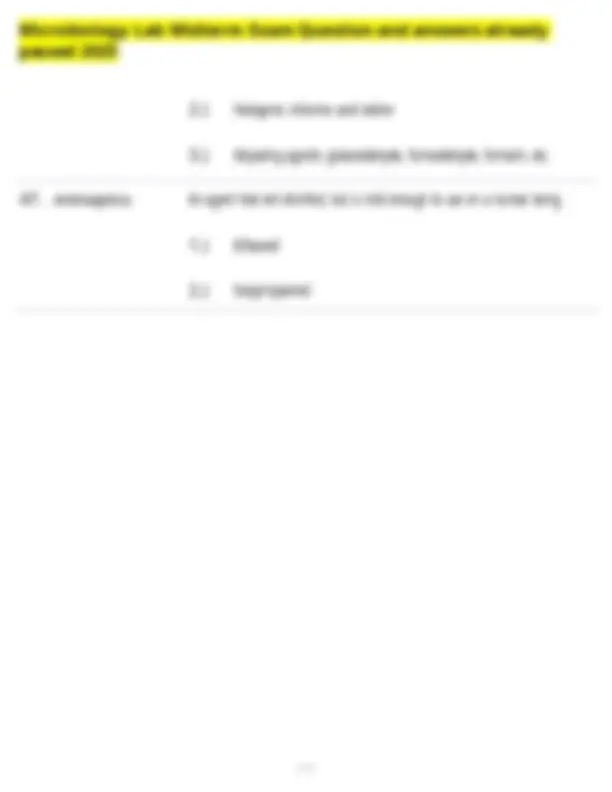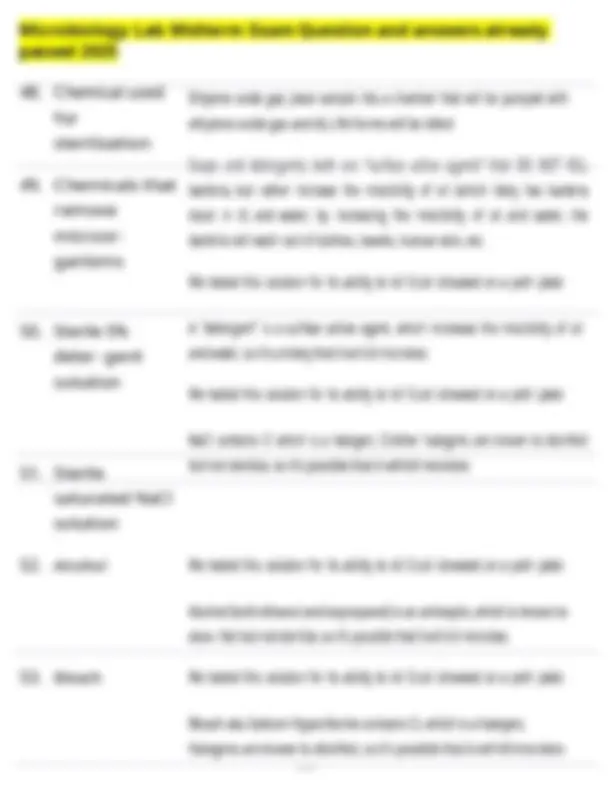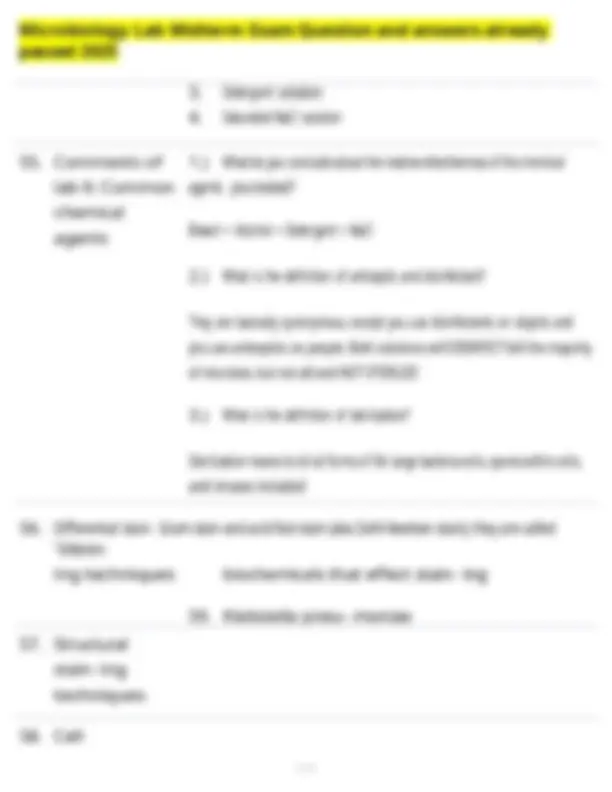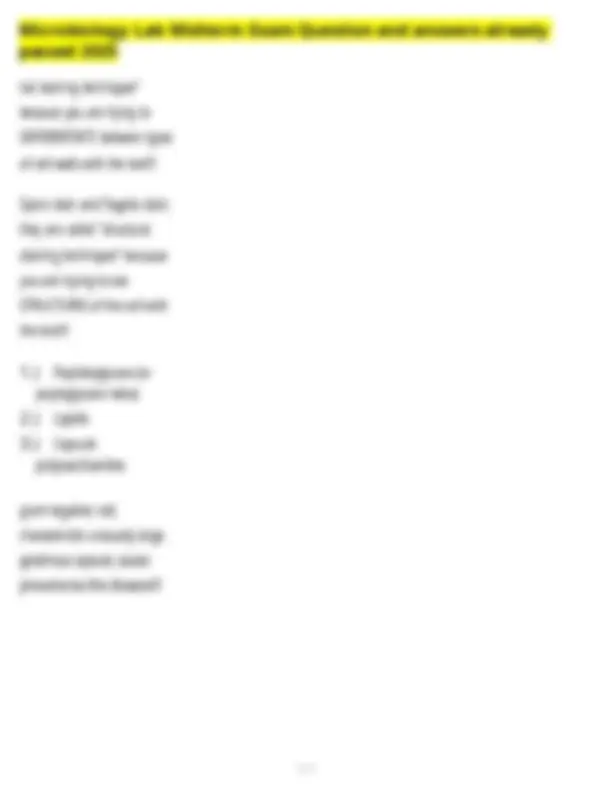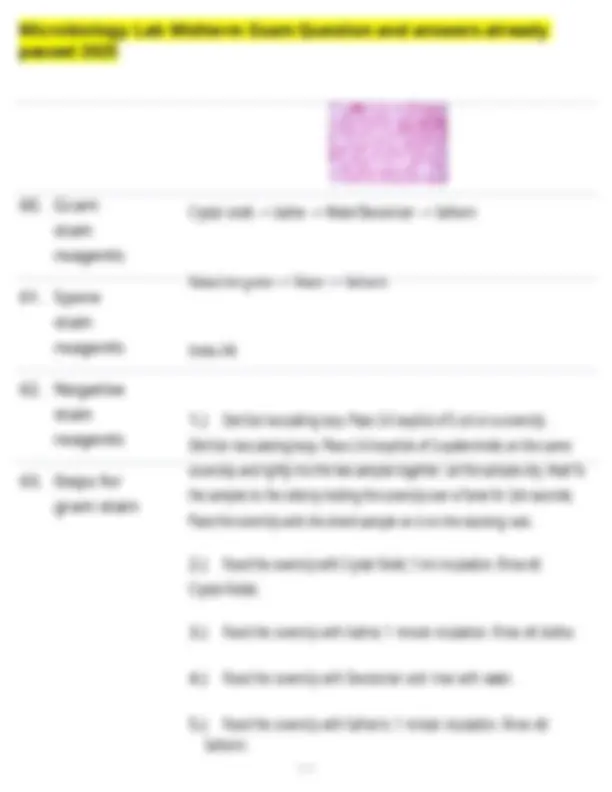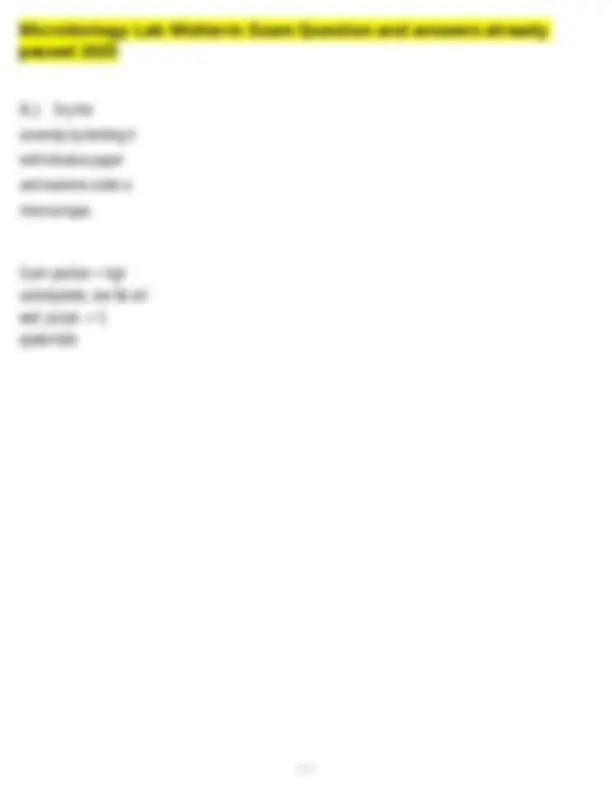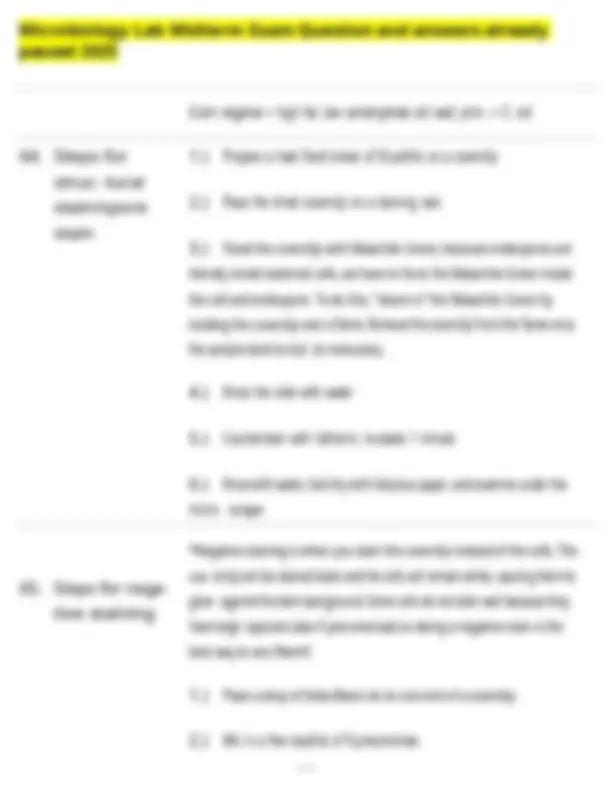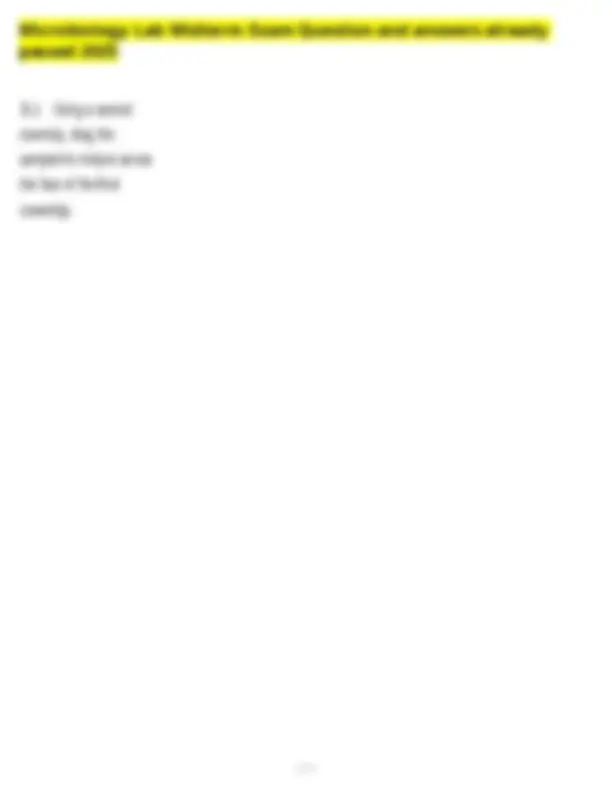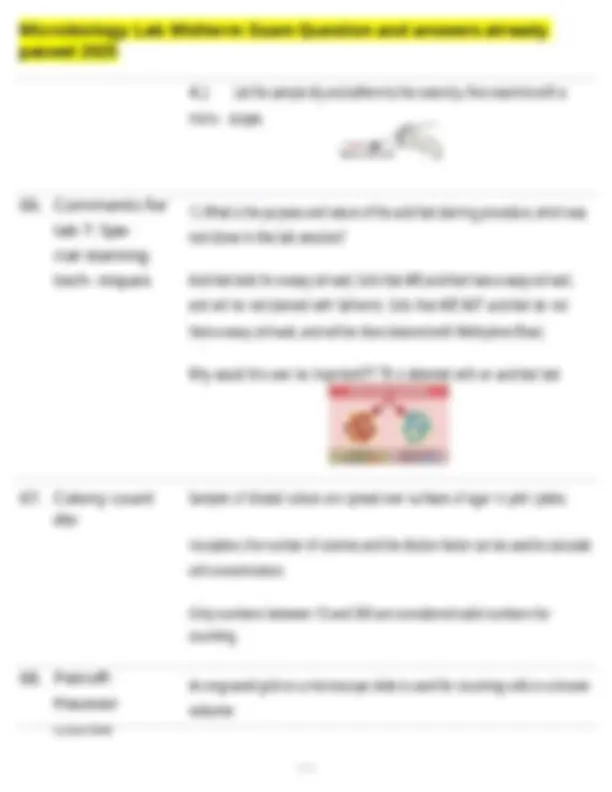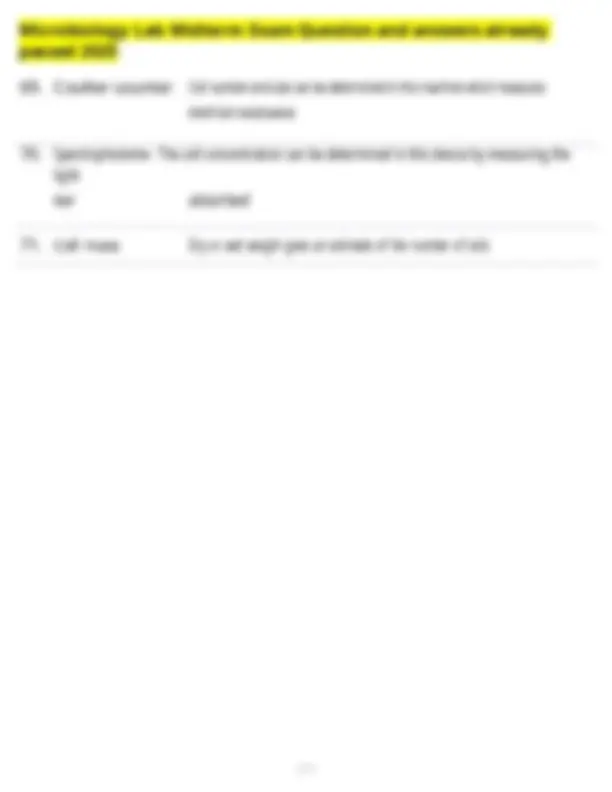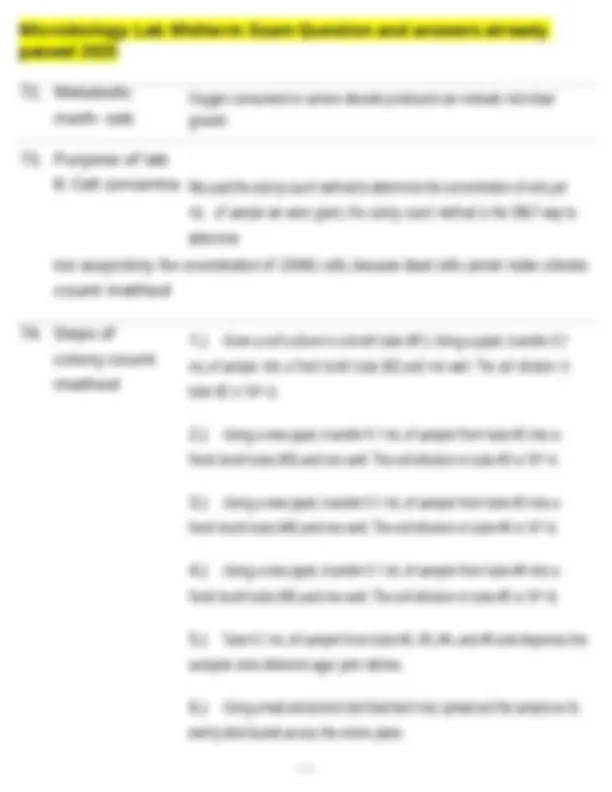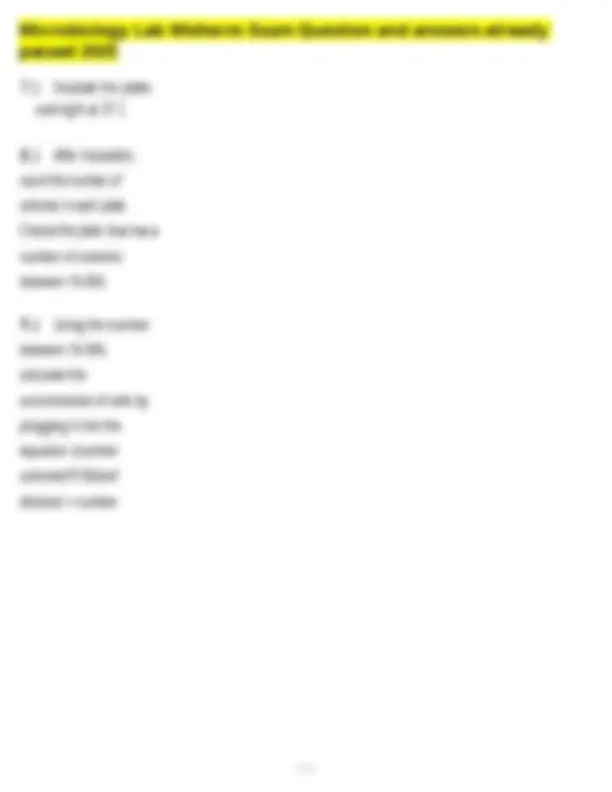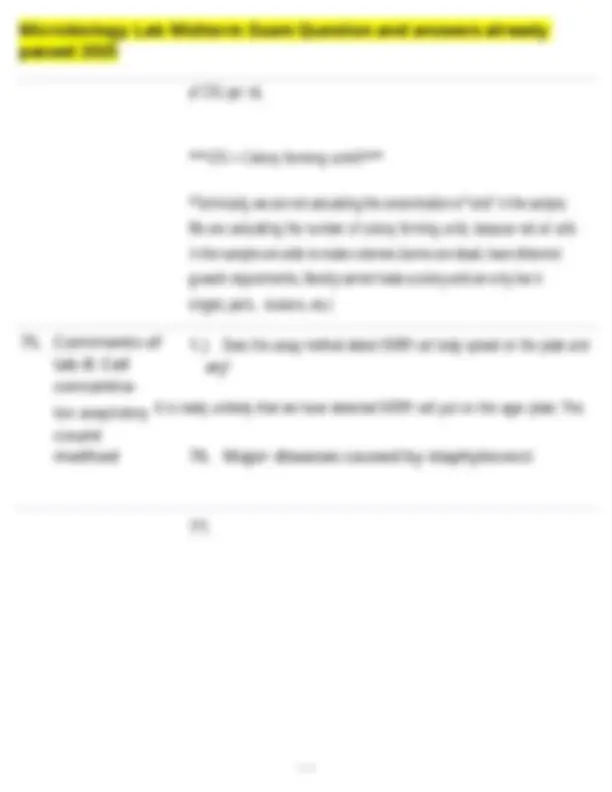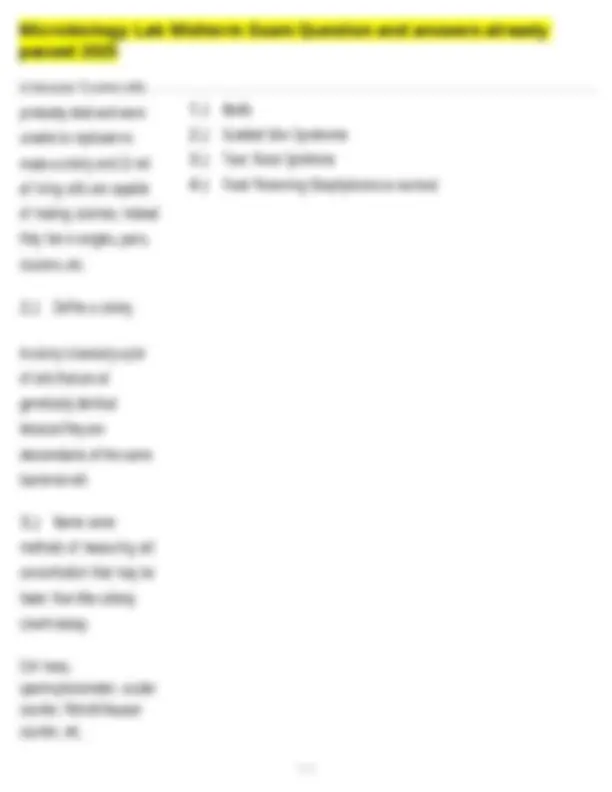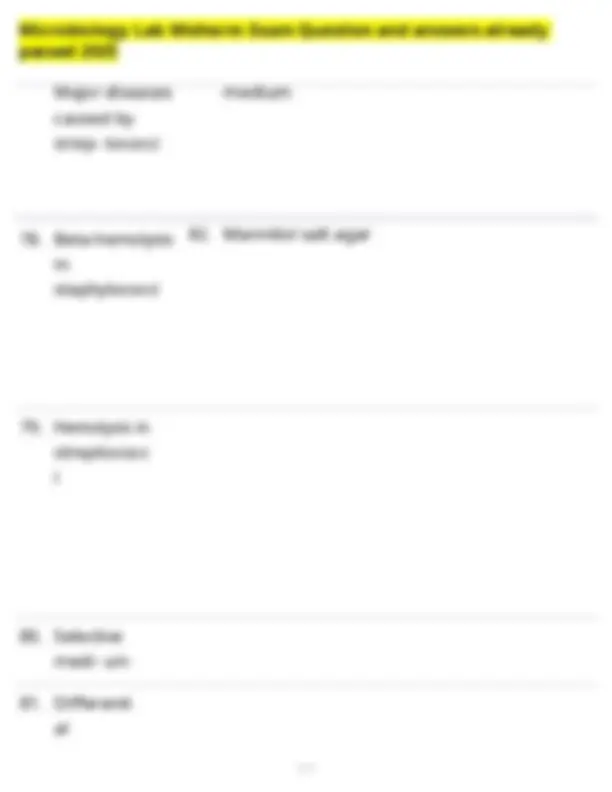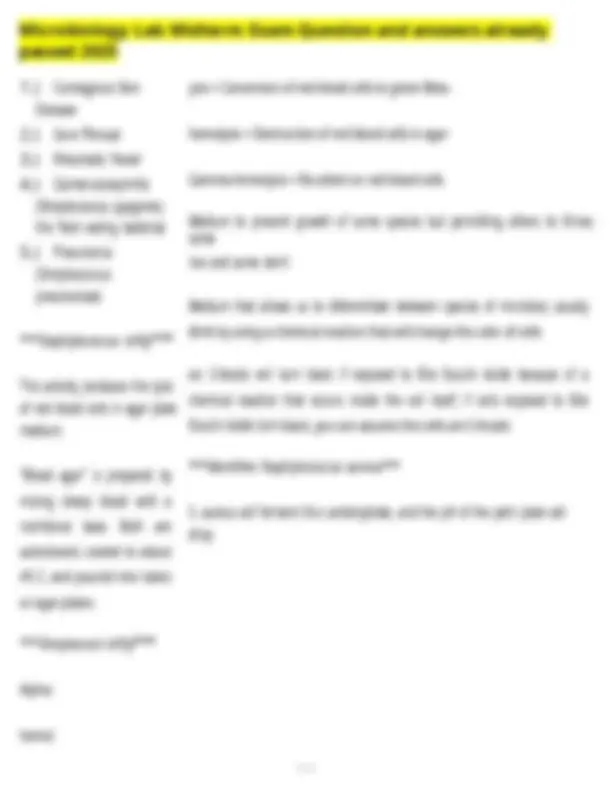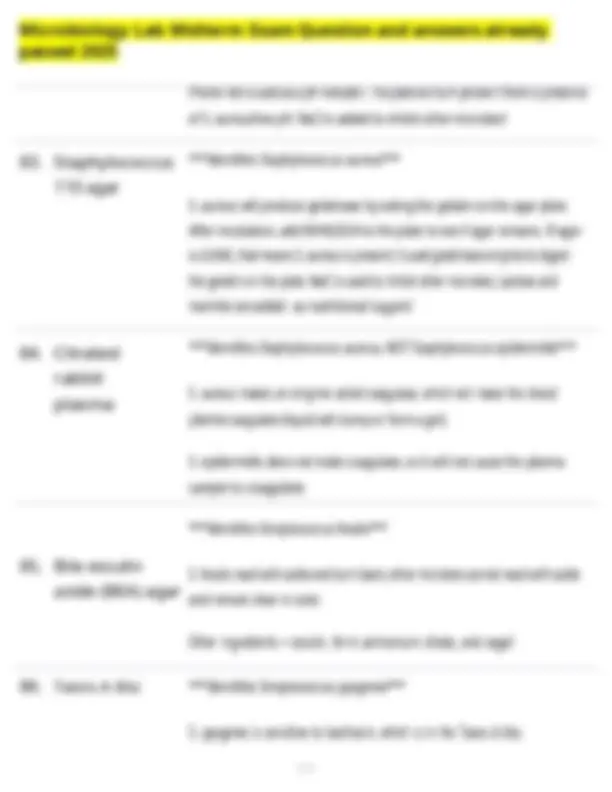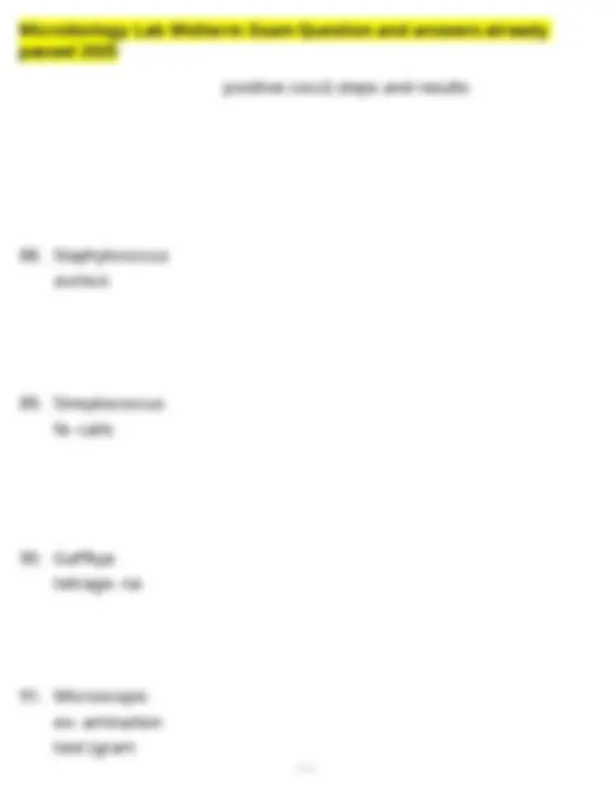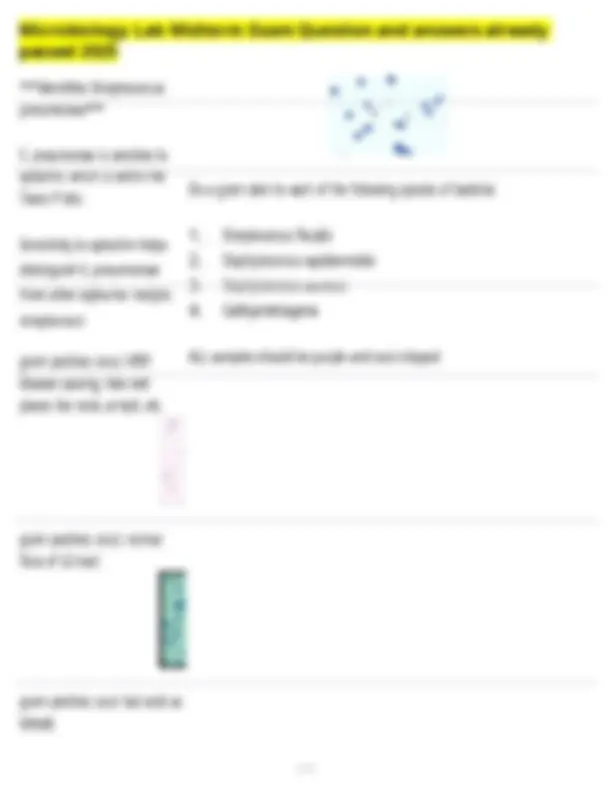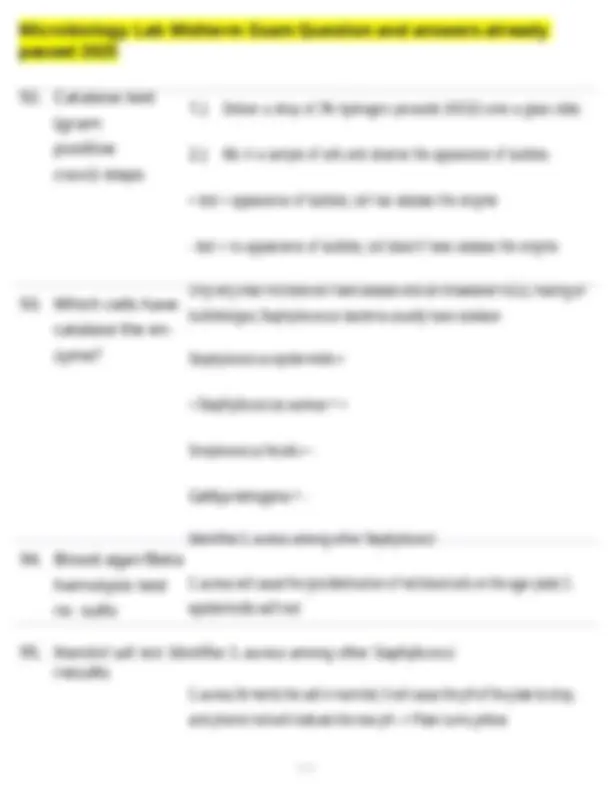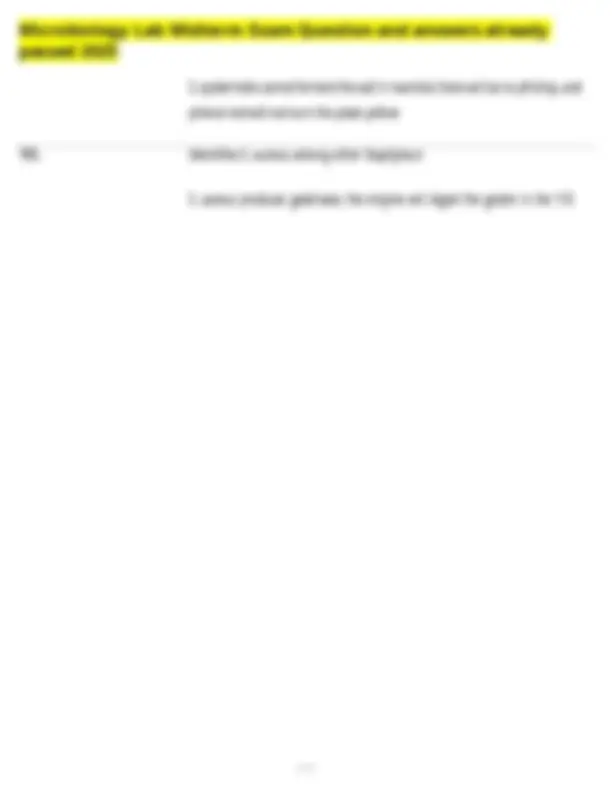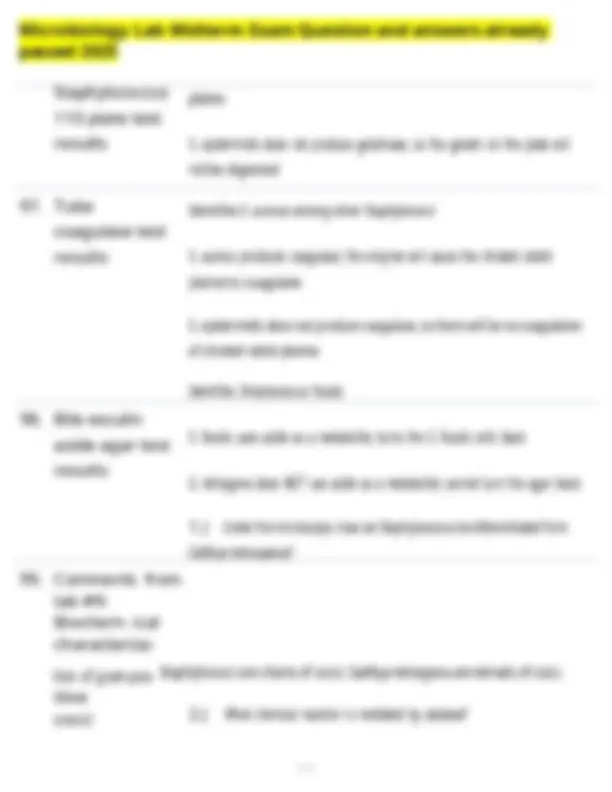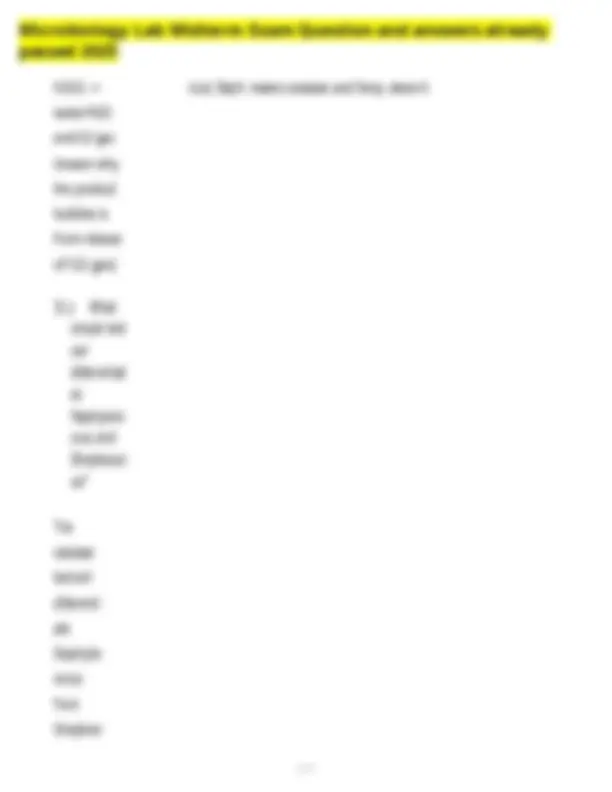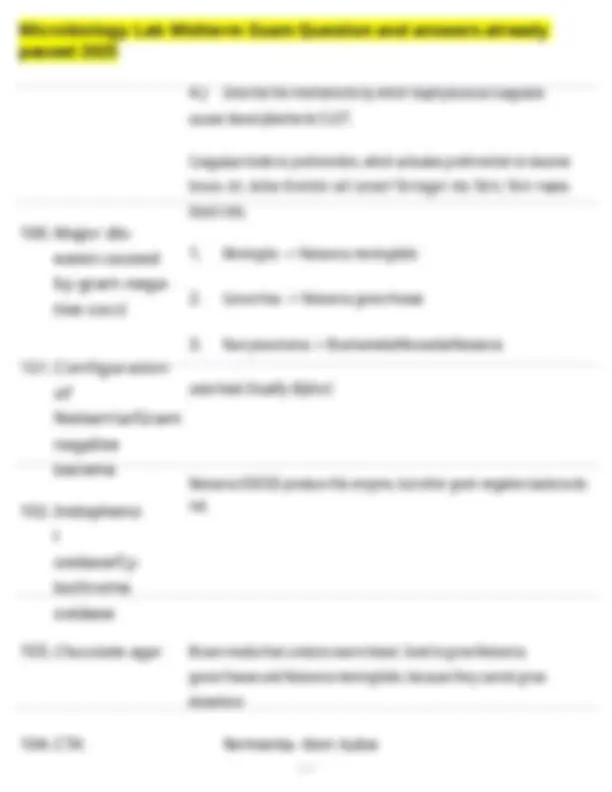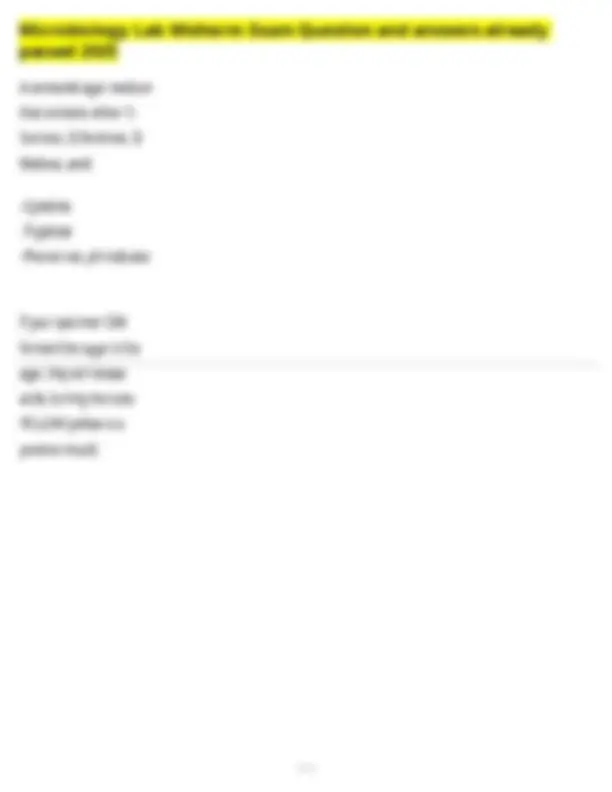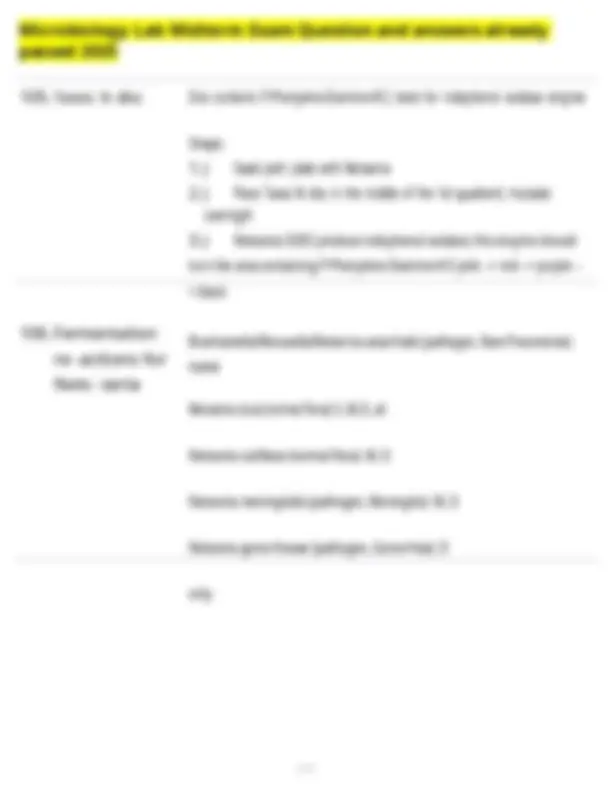Download Microbiology Lab Midterm Exam Question and answers already passed 2025 and more Exams Microbiology in PDF only on Docsity!
passed 2025
- Autochthonous Referring to a microorganism that is native to a location
- Allochthonous Referring to a microorganism that is NOT native to a location
- Aerobe A microorganism that needs oxygen for growth
- Anaerobe A microorganism that can thrive in the absence of oxygen
- Facultative anaerobe
- Methods for growing anaer- obes
- Why would be- ing an aerobic organism be ad- vantageous???
- What is the dom- A microorganism that can grow under aerobic OR anaerobic conditions 1.) Anaerobic chamber or glove box 2.) Anaerobic jar 3.) Roll tube 4.) Thioglycolate broth tube Using O2 is important for metabolism; if O2 is used in metabolism, the organism can make a LOT more ATP Reason why higher life forms require O2 for life Anaerobic organisms are the most dominant life form; many more anaerobic inant life form on organisms on earth than aerobic earth???
passed 2025
- Specifics about anaerobic jars ex: Clostridium tetani --> Tetanus infection ex: Clostridium diflcile --> CDIF ex: Clostridium botulina --> Botulism ex: Clostridium perfringens --> Gangrene Used to grow anaerobic bacteria
passed 2025 1.) Put petri plate in jar 2.) Add PALLADIUM pellets and water, which will absorb the oxygen in the jar 3.) If excess oxygen remains, the filter paper in the jar will turn from white to blue (oxygen detection) 4.) Incubate the petri plates in the jar for a few days to allow growth of anaerobic bacteria Same bacteria as the bacteria in GI tract; no oxygen Used to grow anaerobic bacteria; same premise as anaerobic jar 1.) Put petri plates in anaerobic chamber 2.) Chamber will remove oxygen 3.) Incubate the petri plates in the chamber for a few days to allow growth of anaerobic bacteria Can hold many more samples than an anaerobic jar Ex: Gonorrhea test 1.) Take a urethral swab 2.) Streak plate with swab 3.) Put plate in a jar 4.) Light a candle, place next to the petri plate in the jar 5.) Close the lid so the candle burns out, producing LOTS of CO 6.) Incubate plates/grow colonies Need to grow a lot of samples/petri plates??? Use CO2 chamber instead 1.) Swab ditterent locations to collect bacteria (throat, sink, soil, armpit, air) 2.) Streak a plate with each swab 3.) Incubate the plates to grow colonies of bacteria
passed 2025
- Comments of lab 1: Testing the en- vironment for mi- croorganisms Do you believe that you samples all of the ditterent types of microorganisms in these environments and why? No, we did not sample ALLL of the ditterent microorganisms in these environ- ments. It's unlikely that every single bacteria cell we swabbed has the same growth requirements. For example, a percentage of the bacterial cells we swabbed probably can't grow at 37 C in a dark environment, and died during incubation.
- Resolving power The ability to show detail or determine two objects as separate
- Numerical aper- ture A mathematical expression used to determine resolving power; GREATER numer- ical aperture = GREATER resolving power
- Oil immersion Placing a droplet of oil on a microscope slide when looking at it under 1,000x; reason we use it is to remove the air between the microscope slide and objective lens to decrease refractive index
- Parfocal Property of microscope which allows objectives to be changed without having to refocus
- Calculation of power/magnifica
- Cell configura- tion Objective lens magnification x Eyepiece magnification How cells are arranged Coccus bacteria = singles, pairs, clusters
passed 2025
- Staphylococcus epidermidis Component of normal skin flora; gram positive; coccus
- Escherichia coli gram negative; rod
- Hanging drop slide technique
- Purpose of lab 2: The microscope in microbiology
passed 2025 Used to examine motility of cells 1.) Remove a square coverslip 2.) Add a droplet of immersion oil on each corner of the square coverslip 3.) Add a few loopfuls of sample to the center of the square coverslip 4.) Invert the cavity slide and place over the square coverslip, so that the oil holds the two slides together (sample is sandwiched in the center) 5.) Place the sample under the microscope and examine for motility The purpose was to examine UNstained bacteria for motility. Once bacterial cells are stained, they can no longer move so their motility cannot be observed (staining kills cells).
passed 2025
- Process of simple Using only 1 dye; purpose is just to observe cells staining 1.) Collect a few loopfuls of sample and place them on the center of a glass slide 2.) Allow the sample to dry onto the slide. Once dry, heat fix the sample to the slide by moving the sample across a flame for 2 seconds 3.) Once the sample is heat fixed to the coverslip, place the coverslip on the
passed 2025
- Comments from lab 3: Simple staining staining rack 4.) Flood the sample with dye (crystal violet or safranin) 5.) Incubate for 1 minute 6.) Wash ott excess sample by rinsing the slide under water 7.) Dry the coverslip with bibulous paper and examine under the microscope What to you think is the purpose of heat-fixing bacteria to a slide for staining? Heat fixing removes the water from the sample, so that the bacteria physically sticks to the coverslip and will not slide ott when flooded with dye. It also dries out and kills the bacteria, making them porous to the stains themselves.
- Colony A large group of cells produced from one cell
- Pure culture A culture of only one strain
- Working under a flame
- Serratia marcescens
- How to inoculate a broth tube
- How to inoculate a slant tube
passed 2025
- How to inoculate a petri dish
- Comments of lab 4: Aseptic tech- nique and cul- ture inoculation 1.) Collect one loopful of sample (E.coli or S.marcescens) 2.) Place the loop in the slant tube and draw the loop back and forth over the agar -- Make sure to scrape sample across the entire length of the agar 1.) Collect one loopful of sample (E.coli or S.marcescens) 2.) Place the loop in one quadrant of the petri plate and scrape back and forth. Make sure to fill just one quadrant of the petri plate 3.) Remove the loop and flame sterilize it 4.) Using the loop, draw out one corner of the first quadrant to move sample into the second quadrant 5.) Move the loop back and forth to inoculate the second quadrant. Make sure to fill just the second quadrant, and not run back into the first Repeat until all 4 quadrants of the plate have been inoculated; heat flame the loop between each quadrant; the reason for doing this is to physically separate out ditterent bacterias into ditterent quadrants of the plate 1.) Did all the colonies on the streak plate look identical? No, not all the colonies on the S. marcescens streak plate looked identical. First, it's likely that the sample was contaminated by microbes in the air, producing colonies that do not contain S. marcescens. Second, S. marcescens is usually red, yet some colonies were white. This is likely because a mutation occurred in one of the cells, which then produced a colony of identical white cells (microbes create new generations every 20 mins, so mutations are likely!)
passed 2025 2.) Define aseptic technique. Aseptic technique is being careful and diligent while working in the laboratory to avoid contamination of your sample. 3.) Define mixed culture.
passed 2025 UV lamps are frequently used to disinfect laboratory surfaces
- Ultrasound DISINFECTION High frequency sound is used in machines to clean instruments or break cells but does not sterilize
passed 2025
- Purpose of lab We inoculated samples with E.coli and sterilized/disinfected them using ditterent 5: Common phys- techniques, then determined which method was the most successful at killing ical agents
- Comments of lab 5: Common phys- ical agents microbes
- Autoclave (zero life; all cells killed)
- Nitrocellulose filter (did a good job of separation)
- Sonicator (didn't do shit)
- Control (obviously going to have the most cells) 1.) Which physical agents were the most ettective? Autoclave > Nitrocellulose paper > Sonicator > Control 2.) What types of radiation besides UV light can be used to kill microbes? A second type of radiation that can be used to kill microbes is Ionizing Radiation. This type of UV radiation will bombard samples with gamma rays, causing muta- tions and other significant damage, so cells are killed.
- Disinfectants An agent that will disinfect; Kills most life forms but not all (doesn't kill spores, viruses, etc.); Acceptable to use on objects but too strong to use on human beings 1.) Phenols: lysol and camphophenique
passed 2025
- Chemical used for sterilization
- Chemicals that remove microor- ganisms
- Sterile 5% deter- gent solution
- Sterile saturated NaCl solution Ethylene oxide gas; place sample into a chamber that will be pumped with ethylene oxide gas and ALL life forms will be killed Soaps and detergents; both are "surface active agents" that DO NOT KILL bacteria, but rather increase the miscibility of oil (which likely has bacteria stuck in it) and water; by increasing the miscibility of oil and water, the bacteria will wash out of clothes, towels, human skin, etc. We tested this solution for its ability to kill E.coli streaked on a petri plate A "detergent" is a surface active agent, which increases the miscibility of oil and water, so it's unlikely that it will kill microbes We tested this solution for its ability to kill E.coli streaked on a petri plate NaCl contains Cl which is a halogen; Cl/other halogens are known to disinfect but not sterilize, so it's possible that it will kill microbes
- Alcohol We tested this solution for its ability to kill E.coli streaked on a petri plate Alcohol (both ethanol and isopropanol) is an antiseptic, which is known to disin- fect but not sterilize, so it's possible that it will kill microbes
- Bleach We tested this solution for its ability to kill E.coli streaked on a petri plate Bleach aka Sodium Hypochlorite contains Cl, which is a halogen; Halogens are known to disinfect, so it's possible that it will kill microbes
passed 2025
- Purpose of lab 6: Common chemi- cal agents We tested the ability of various substances to kill E.coli streaked on a petri plate. The agents we tested were:
- Bleach
- Alcohol

